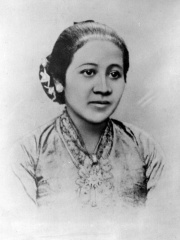
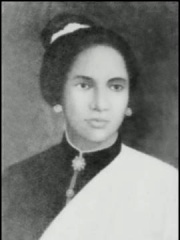
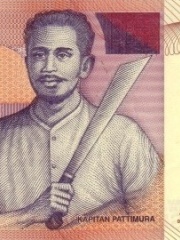
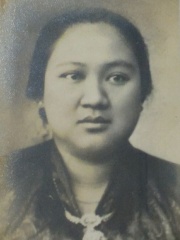
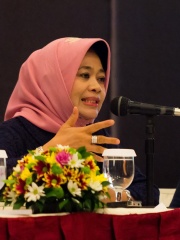
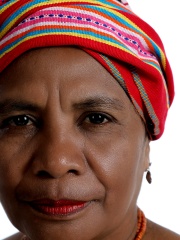
The Most Famous
SOCIAL ACTIVISTS from Indonesia
This page contains a list of the greatest Indonesian Social Activists. The pantheon dataset contains 840 Social Activists, 2 of which were born in Indonesia. This makes Indonesia the birth place of the 52nd most number of Social Activists behind Myanmar (Burma), and Algeria.
Top 7
The following people are considered by Pantheon to be the most legendary Indonesian Social Activists of all time. This list of famous Indonesian Social Activists is sorted by HPI (Historical Popularity Index), a metric that aggregates information on a biography’s online popularity.

1. Kartini (1879 - 1904)
With an HPI of 58.69, Kartini is the most famous Indonesian Social Activist. Her biography has been translated into 32 different languages on wikipedia.
Raden Adjeng Kartini, also known as Raden Ayu Kartini (21 April 1879 – 17 September 1904), was a prominent Indonesian activist who advocated for women's rights and female education. She was born into an aristocratic Javanese family in the Dutch East Indies (present-day Indonesia). After attending a Dutch-language primary school, she wanted to pursue further education, but Javanese women at the time were barred from higher education. Instead, Kartini entered a period of seclusion mandated for teenage girls until they married. She acquired knowledge by reading books and by corresponding with Indonesian and Dutch people. Her father allowed her to go into the community beginning in 1896, although she remained an unmarried single woman. She met various officials and influential people, including J.H. Abendanon. She began the tradition amongst three of her sisters to found and operate schools. After she died, schools were established by a foundation founded in the Netherlands. Some of her Indonesian friends also established Kartini Schools. After her death, her sisters continued her advocacy of educating girls and women. Kartini's letters were published in a Dutch magazine and eventually, in 1911, as the works: Door Duisternis tot Licht (From Dark Comes Light) and an English version, Letters of a Javanese Princess. Her birthday is now celebrated in Indonesia as Kartini Day in her honor. She opposed the Purdah-like seclusion of teenage girls and polygamy. Kartini is a National Hero of Indonesia.

2. Cut Nyak Dhien (1850 - 1908)
With an HPI of 53.63, Cut Nyak Dhien is the 2nd most famous Indonesian Social Activist. Her biography has been translated into 22 different languages.
Cut Nyak Dhien or Tjoet Nja' Dhien (c. 1848 – 6 November 1908) was a leader of the Acehnese guerrilla forces during the Aceh War. Following the death of her husband Teuku Umar, she led guerrilla actions against the Dutch for 25 years. She was posthumously awarded the title of National Hero of Indonesia on 2 May 1964 by the Indonesian government.

3. Pattimura (1783 - 1817)
With an HPI of 51.97, Pattimura is the 3rd most famous Indonesian Social Activist. His biography has been translated into 15 different languages.
Thomas Matulessy (8 June 1783 – 16 December 1817), also known as Kapitan Pattimura or simply Pattimura, was a famous Ambonese soldier who became a symbol of both the Maluku and Indonesian struggle for independence, praised by President Sukarno and declared a national hero by President Suharto. He has several namesakes in both the Netherlands and in the Indonesian archipelago. Born on the island of Ceram, Pattimura joined the British Colonial Auxiliary Forces after they took the Maluku islands from the French. When the islands were returned to the Dutch in 1816, he was dismissed. The return of the Dutch in 1816 marked a change in the colonial system. After the bankruptcy of the Dutch East India Company, the Indonesian archipelago came under the control of the newly founded Kingdom of the Netherlands. This was accompanied by, among other things, the establishment of a colonial army: KNIL. Christian Moluccans in particular were wanted as ethnic soldiers in the KNIL. Despite Pattimura's revolt, the myth of a centuries-long loyalty of Moluccans to the Netherlands and the royal family began. Pattimura and his followers feared harsher colonial oppression than the English under whom he had served. On 16 May 1817, Pattimura led an armed rebellion that captured Fort Duurstede, killing the inhabitants of the fortress and fighting off Dutch reinforcements, on 29 May he was declared the leader of the Moluccan people. After being betrayed by the King of Booi Pati Akoon, he was captured by Dutch forces on 11 November and hanged the next month.

4. Dewi Sartika (1884 - 1947)
With an HPI of 48.95, Dewi Sartika is the 4th most famous Indonesian Social Activist. Her biography has been translated into 16 different languages.
Dewi Sartika (4 December 1884 – 11 September 1947) was an advocate for and pioneer of education for women in Indonesia. She founded the first school for women in the Dutch East Indies. She was honoured as a National Hero of Indonesia in 1966.
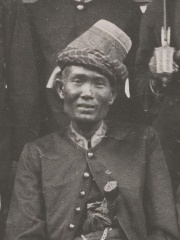
5. Teuku Umar (1854 - 1899)
With an HPI of 48.01, Teuku Umar is the 5th most famous Indonesian Social Activist. His biography has been translated into 15 different languages.
Teuku Umar (1854 – 11 February 1899) was a leader of a guerrilla campaign against the Dutch in Aceh during the Aceh War. He fell when Dutch troops launched a surprise attack in Meulaboh. His body was buried in the Mugo area. After Teuku Umar's death, his wife Cut Nyak Dhien continued to lead the guerrillas against the Dutch. He was later made a Pahlawan Nasional Indonesia (National Hero of Indonesia).

6. Siti Musdah Mulia (b. 1958)
With an HPI of 39.64, Siti Musdah Mulia is the 6th most famous Indonesian Social Activist. Her biography has been translated into 21 different languages.
Siti Musdah Mulia (born 1958) is an Indonesian women's rights activist and professor of religion. She was the first woman appointed as a research professor at the Indonesian Institute of Sciences, and is currently a lecturer of Islamic political thought at the School of Graduate Studies at Syarif Hidayatullah State Islamic University. Since 2007, Musdah has served as chairperson of the NGO Indonesian Conference on Religion and Peace, which aims to promote interfaith dialogue in Indonesia. She also served as director of the Megawati Institute, a think-tank established by former president Megawati Soekarnoputri.

7. Aleta Baun (b. 1966)
With an HPI of 30.88, Aleta Baun is the 7th most famous Indonesian Social Activist. Her biography has been translated into 15 different languages.
Aleta Baun is an Indonesian environmental activist. She has been described as the Indonesian Avatar. She won the 2013 Goldman Environmental Prize for organizing hundreds of local villagers to peacefully occupy marble mining sites in “weaving protests,” to stop destruction of sacred forest land on Mutis Mountain on the island of Timor. A leader of indigenous Mollo people, she was born to a family of farmers. Having lost her mother at a young age, she was raised by other women and elders in the village who taught her to respect the environment as a source of their spiritual identity and livelihood. As a community leader sharing traditional knowledge, she eventually became known as “Mama Aleta.” Mama Aleta's work made her a target for the mining interests and local authorities, who put a price on her head. After surviving an assassination attempt, Mama Aleta went into hiding in the forest with her baby. Despite intimidation, Mama Aleta grew the movement to include hundreds of villagers. It culminated in a weaving occupation where 150 women spent a year sitting on the marble rocks at the mining site, quietly weaving their traditional cloth in protest. Because women were traditionally responsible for getting food, dye and medicine from the mountains, mining in these mountains would have directly impacted their livelihoods. While the women protested at the mine, the men provided domestic support at home, cooking, cleaning and caring for the children. In the face of the villagers’ peaceful and sustained presence, marble mining became an increasingly untenable endeavor for the companies involved. Public awareness of the weaving occupation was growing, and Indonesian government officials took notice. By 2010, the mining companies, reacting to the pressure, halted mining at all four sites within the Mollo territories and abandoned their operations. Mama Aleta now helps communities across West Timor to map their traditional forests. She works in water security and indigenous peoples natural resource management and land rights. She said to the Jakarta Post: “We especially want to conserve the upstream region of our territory because it is a watershed for the entire island. We are considering a joint title for our three communities and placing the land under collective ownership of the communities”. To help with this, she obtained a law degree in 2011 from Universitas Tritunggal Surabaya.
People
Pantheon has 7 people classified as Indonesian social activists born between 1783 and 1966. Of these 7, 2 (28.57%) of them are still alive today. The most famous living Indonesian social activists include Siti Musdah Mulia, and Aleta Baun. The most famous deceased Indonesian social activists include Kartini, Cut Nyak Dhien, and Pattimura. As of April 2024, 5 new Indonesian social activists have been added to Pantheon including Pattimura, Dewi Sartika, and Teuku Umar.
Living Indonesian Social Activists
Go to all RankingsDeceased Indonesian Social Activists
Go to all RankingsKartini
1879 - 1904
HPI: 58.69
Cut Nyak Dhien
1850 - 1908
HPI: 53.63
Pattimura
1783 - 1817
HPI: 51.97
Dewi Sartika
1884 - 1947
HPI: 48.95
Teuku Umar
1854 - 1899
HPI: 48.01
Newly Added Indonesian Social Activists (2024)
Go to all RankingsPattimura
1783 - 1817
HPI: 51.97
Dewi Sartika
1884 - 1947
HPI: 48.95
Teuku Umar
1854 - 1899
HPI: 48.01
Siti Musdah Mulia
1958 - Present
HPI: 39.64
Aleta Baun
1966 - Present
HPI: 30.88
Overlapping Lives
Which Social Activists were alive at the same time? This visualization shows the lifespans of the 5 most globally memorable Social Activists since 1700.

